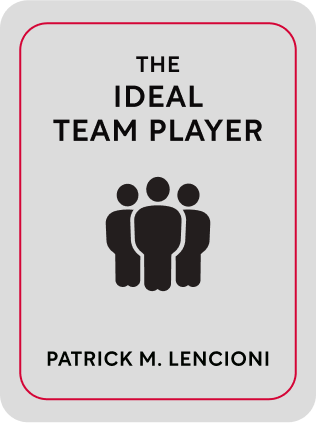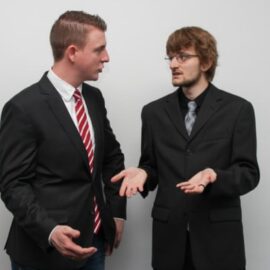

This article is an excerpt from the Shortform book guide to "The Ideal Team Player" by Patrick M. Lencioni. Shortform has the world's best summaries and analyses of books you should be reading.
Like this article? Sign up for a free trial here .
What are the three virtues of Patrick Lencioni’s ideal team player? How does cultivating these qualities in your employees help you level up their performance?
In his book The Ideal Team Player, Patrick Lencioni explains how to spot, hire, and coach a model team player—someone who is humble, hungry, and smart. Through the fictional story of a man who takes over his uncle’s troubled construction company, he explains how these three simple qualities combined can transform any organization.
Here goes the fable of Patrick Lencioni’s ideal team player model.
The Fable
In Patrick Lencioni’s The Ideal Team Player, Bob Shanley, founder and owner of Valley Builders, a large Napa Valley construction firm, was approaching retirement and looking for someone to take over his business. His nephew, Jeff Shanley, who’d spent two decades in marketing in Silicon Valley, was looking for a new challenge.
None of Bob’s siblings or children was involved in or interested in running the 200-employee company. Meanwhile, Jeff had done some successful consulting work with Valley Builders’ executive team—he and Bob liked and respected each other. So Bob agreed to train his nephew as his successor. Jeff, his wife Maurine, and their children moved to Napa Valley, and Jeff focused on learning the construction business.
Jeff’s education in the construction business was short-circuited, however, when Bob developed heart problems; he needed immediate surgery and had to step down. Jeff suddenly found himself becoming the new CEO.
Adding to Jeff’s challenges, Valley Builders had just landed two large projects—a hospital and a hotel. The company had done projects like these before, but it had never done two major projects at the same time. Bob assured Jeff they had the capability—they just needed to significantly increase staff.
Valley Builders’ top executives, besides Bob, were Clare Massick, head of administration, finance, legal, and HR; and Bobby Brady, vice president of field operations. Jeff had a frank discussion with them. While they acknowledged concerns about Jeff’s inexperience, they felt he was trustworthy and, as a Shanley, would be personally invested in the company’s success. Further, Bobby said he liked the fact that Jeff listened and wasn’t a “jackass” to work with. They agreed to work as a team.
Challenges
The biggest issue immediately facing the company was labor. For the new hospital and hotel projects, they’d need to add 60 people in the next two months. In addition, progress was stalling on the Oak Ridge building site, a problematic shopping center project that Valley Builders was trying to finish.
Feeling the pressure, Jeff talked one evening with his wife Maurine, who expressed confidence that Jeff could handle the challenges. Still, Jeff worried that the job could affect his relationship with his family if he screwed it up. Maurine advised him to just tackle one issue at a time.
Jeff learned more from Clare and Bobby about their staffing issues. The company had been experiencing significant turnover (33%) on its projects, so Bobby advised that they hire 80 people to get 60, since 20 would likely quit.
They’d be able to fill the lower-level jobs without a problem, Clare said, but finding a manager for the hospital project and three foremen would be more difficult—they’d lost two foremen a few months ago, so they were already behind. The foremen had quit because one of the two managers for the Oak Ridge project, Nancy Morris, was difficult to get along with and allowed problems to fester.
As the founder of Valley Builders, Bob had always stressed teamwork (he’d hired Jeff in the past to do teamwork training with his executives), but the concept hadn’t been pushed beyond the management team. So the company was being hamstrung by morale and turnover problems.
In fact, when Jeff questioned Clare and Bobby, he realized they couldn’t define what teamwork meant at Valley Builders or how they knew whether potential hires would be team players.
The only criterion seemed to be the one Bobby had used in describing Jeff: they tried to avoid hiring “jackasses” that others wouldn’t like working with. They couldn’t define jackass, however, and acknowledged they had relied on Bob’s intuition for who would be a good fit for the company.
Jeff knew he had a lot to learn about construction, but he was clear on one thing: they needed to only hire team players. Also, they had to find out how many non-team players they had working for them and get them to change or leave. Otherwise, they wouldn’t complete the hospital and hotel projects—or even keep Valley Builders in business in the long term.
What’s a Team Player?
The first step would be figuring out how to identify a team player.
That afternoon, Jeff talked with his cousin Ben, a school teacher and basketball coach (and Bob’s son) to get his thoughts on essential characteristics of team players. Ben said the key qualities were that they worked hard and weren’t prima donnas—they focused on helping the team succeed.
Next, Jeff and his two top managers went through a list of people the company had let go or had problems with in the past few years, looking for common denominators among non-team players. They came up with a fairly predictable list of negative traits: negative, lazy, self-centered, insensitive, and irresponsible.
Jeff, Clare, and Bobby soon got to test their own ability to identify team players: They decided to add a fourth top executive to their team, to help get the two big building projects done on time. Bobby had a highly qualified candidate in mind: Ted Marchbanks, a former division chief for a big construction company, who had retired recently.
They had a get-acquainted lunch with Ted and he came across as smooth and knowledgeable. Bobby wanted to hire him immediately, but Jeff and Clare didn’t have a sense yet of whether he’d be a team player.
Again, they tried to figure out what they wanted in a team player by examining the opposite—a non-team player or jackass. They came up with: overbearing, inappropriate, and clueless—which seemed to describe Nancy, the problematic manager on the Oak Ridge project. Clare commented that Nancy wasn’t upsetting people intentionally—she just wasn’t “socially smart” when it came to dealing with others. Regarding Ted, they agreed that he seemed smart about dealing with people.
Having people skills seemed important to being a team player, but Jeff thought there was more to it. Based on their analysis of past and current employees, plus his conversation with his cousin Ben (the basketball coach), three key qualities began to gel in Jeff’s mind: lack of ego, willingness to work hard, and being smart about people.
A Test Run
Ted’s formal interview was scheduled for the next day. Before meeting with him, the three senior executives further refined the three team player qualities that Jeff had identified.
They decided that working hard meant more than just putting in a certain number of hours—it also meant having motivation, passion, and a sense of urgency about the work. It meant going beyond what was expected—being hungry.
The other quality they’d talked about, being smart about people, was different from being intelligent. It was knowing how to act and what to say and not say, plus being aware of the impact of your words and actions on others. It was something like emotional intelligence but less complicated. But a person who was smart could still be a non-team player or jackass, by charming or manipulating people for his own ends.
The third quality they’d identified was a lack of ego. People with big egos were the opposite of a team player: focused on themselves and were arrogant. The opposite of arrogance is humility, which was the quality they were looking for.
So an ideal team player would be humble, hungry, and smart. They planned to use the model for evaluating job candidates, starting with Ted. Since they knew he was smart or skilled at dealing with people, their goal would be to determine whether he was humble and hungry (driven).
A number of managers met with Ted and, between the interviews, they discussed their impressions and determined what issues the person scheduled to meet with Ted next should dig into more deeply.
Craig, the Oak Ridge project manager, thought Ted was hungry; he definitely wanted the job, and he wanted to be busy again. Clare couldn’t get a read on whether he was humble or not. But she did notice something that stuck with her—he hadn’t bothered to learn her receptionist, Kim’s, name although Kim had been escorting him around the building all day. Still, she thought they should hire him, as did Bobby.
When Jeff asked Kim for her impressions of Ted, she noted that Ted had waited in the lobby for 15 minutes that morning without noticing her. His only comments to her throughout the day were to ask her where the restroom was and if she could charge his phone. Jeff felt that treating administrative staff dismissively suggested that Ted lacked humility.
When he interviewed Ted over lunch, Jeff looked for indications that Ted was humble. He asked Ted how his former coworkers would describe him. Ted said he was well-liked by coworkers, but he got slightly annoyed when Jeff asked if that included administrative staff. He said he’d never had any problems with people.
Jeff explained to build a culture of teamwork, Valley Builders only hired people who were humble, hungry, and smart about dealing with others. Anyone who didn’t share these values would be uncomfortable working at the company. Finally, Jeff asked Ted for names of people he could talk to at Ted’s old company about whether he’d be a good fit for Valley Builders. Ted hesitated; he said he’d send a few names in the afternoon. But by the end of day, he hadn’t done so.
Meanwhile, Clare called the HR director at his previous company, who was noncommittal about Ted’s attitude toward the staff there. Then Jeff got a call from Ted, who said he’d decided to withdraw from consideration because he wasn’t ready to give up retirement and go back to work.
Things Come Together
When they learned that Ted had backed out, Clare and Bobby questioned whether they were being too idealistic or simplistic with their model and had chased away a good candidate.
That night, Jeff talked it over with Maurine, who said the fact that the model was simple didn’t mean it was wrong. Besides, she said, Ted sounded like a total politician—and when you hire a politician, you get someone with an ego who creates complications.
To further test the team player model, Jeff decided to see whether evaluating people against the model would help them understand and solve their problems at the Oak Ridge site.
Jeff, Clare, and Bobby discussed the on-site managers. Nancy was humble and hungry, but definitely not smart about people. She inadvertently created a lot of problems that had to be cleaned up. Of her two foremen who had quit, Pedro was a complete team player, while Carl lacked hunger or motivation.
They decided that Craig, the other project manager, was also humble, hungry, and smart. Suddenly, Bobby had an epiphany: they should promote Craig to the executive team—he’d definitely fit in better than Ted. At that moment, they all realized that hiring Ted would have been a mistake. Further, Craig was the right choice.
Meanwhile, Jeff met with Nancy to determine whether she recognized her weakness and would be willing to do what it took to become a team player. He invited her to his office and explained the three qualities they were looking for in a team player: humility, hunger, and people skills. They agreed that her strongest area was working hard (being hungry); she also felt she was humble, or at least not arrogant. But she acknowledged that she focused on getting things done more than on being nice, and therefore wasn’t good at social interaction. She was willing to work on getting better at it.
A Few Months Later
The employees were overwhelmingly positive about Craig’s promotion, and he did well in the new position. Meanwhile, two references—an administrative employee at Ted’s old company and also one of his former clients—called and told Jeff that Valley Builders had dodged a bullet by not hiring him: Ted always put his own interests first.
Clare created a new hiring program; all hiring managers were trained in how to hire team players. They hired some strong senior managers and this made hiring the right people at other levels easier. One of the biggest pluses was rehiring the foreman Pedro, who had left in disgust. Nancy had contacted Pedro and admitted she’d let him down by being difficult to work with and not confronting personnel issues, but said she was working to do better in the future.
Jeff met with each of the company’s 17 foremen and project leaders, as he had with Nancy, to talk about the need for teamwork and the qualities everyone needed to demonstrate. Only one person ended up leaving.
A Year Later
Craig became an effective leader, working closely with Bobby on oversight of the hospital and hotel projects, both of which Valley Builders completed successfully. Nancy became Craig’s best employee. The three team player qualities became part of the regular conversation at Valley Builders, and teams were more effective in delivering results.
Turnover declined, morale improved, and client satisfaction grew. Instead of using outside recruiters and headhunters to identify job candidates, they found they could easily fill positions by word of mouth and employee referrals. Valley Builders had become known not only as a great place to work but, as Bobby put it, as a jackass-free zone.

———End of Preview———
Like what you just read? Read the rest of the world's best book summary and analysis of Patrick M. Lencioni's "The Ideal Team Player" at Shortform .
Here's what you'll find in our full The Ideal Team Player summary :
- The qualities of a model team player
- How to transform your organization by developing your current employees into team players
- How to make sure you hire team players in the future






